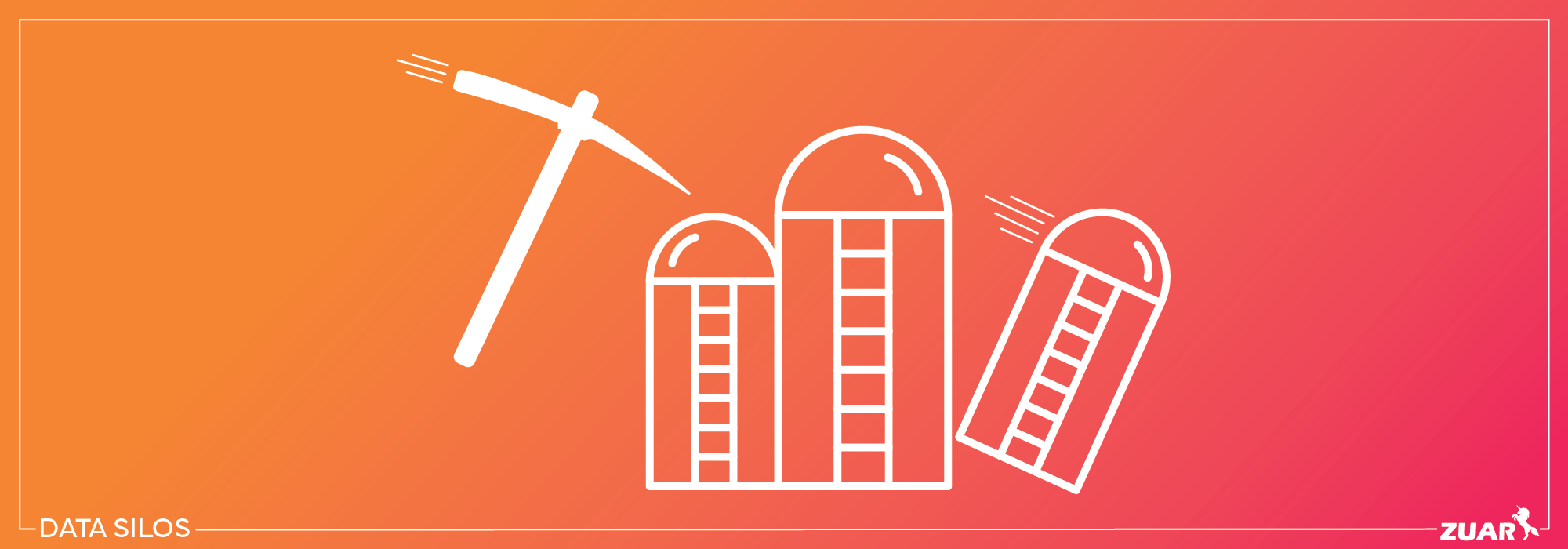Breaking Down Data Silos: A Roadmap to Improved Efficiency
Learn what data silos are and the tools and methods required to overcome them.

Overview
Are you struggling with disjointed data, slow decision-making, and poor collaboration among departments? It’s time to break down the barriers that are holding your organization back.
Data silos are a widespread problem that can have severe consequences on businesses’ efficiency and growth.
This article will provide a comprehensive strategy to help you understand, identify, and eliminate data silos, ultimately leading to improved operations and a better experience for your customers.
Learn more how to transform data silos into integrated intelligence from Zuar's co-founder, Joel Stellner:

Understanding Data Silos

Data silos are isolated data repositories that restrict information sharing and collaboration, leading to negative impacts on business operations and decision-making.
One might ask, “Why are data silos a problem?” Their contribution to inefficient data management often prevents data from being shared between departments, leading to duplicate or inaccurate data.
They prevent teams and departments from obtaining a unified view of valuable data, hindering agility, adaptability, and overall efficiency.
The 'data silo problem' can be addressed through data integration, which involves combining data from multiple sources into a unified view, allowing organizations to identify data silos and effectively tackle them.
Data integration typically involves a set of disparate data sources, clients, and a master server that provides a consolidated view of all data, helping to eliminate inconsistent data and improve decision-making.
Approaches such as extraction, transformation, and loading (ETL) and extract load, transform (ELT) are employed to consolidate data into a single repository, such as a data warehouse or data mart.
Data integration enables organizations to obtain a comprehensive view of their customers, fostering improved decision-making.
Causes of Data Silos
Multiple factors contribute to the emergence of data silos, such as:
- An array of data sources
- Organizational growth
- Structural frameworks
- Technological limitations
- Protective gatekeeping
The primary factor leading to unintentional data silos is decentralized IT services, where data silos occur as departments procure their software and technologies without verifying compatibility with existing systems.
Moreover, many organizations rely on Software-as-a-Service (SaaS) applications to manage their core processes, but these applications often lack direct integration capabilities.
Organizational structures and company culture can also contribute to data silos. In some cases, there is no one responsible for making data accessible across the organization, and a culture that promotes independent working and 'data ownership' rather than 'data sharing' can exacerbate the issue.
Competitive gatekeeping, where teams within an organization retain control by withholding data from others, further fuels data silo formation.
Impact on Business Operations
The detrimental effects of data silos include:
- Inefficiency and fragmented data
- Adverse effects on customer service interactions, causing stress for support agents and dissatisfaction among customers
- Lack of access to valuable customer insights for sales, product, and marketing teams, hindering their ability to make informed decisions and develop effective strategies
Data silos can also increase security risks if proper measures are not taken and impede agents from delivering satisfactory customer experiences by not having the necessary information when interacting with customers.
Breaking down data silos can lead to improved business operations through increased efficiency and a comprehensive overview of information.

The Cost of Data Silos
Data silos incur a mix of both tangible and intangible costs. Data silos can also lead to increased storage and staffing costs, as well as decreased trust and collaboration among departments.
To mitigate these costs, organizations should focus on strategies to eliminate data silos, such as encouraging cross-team collaboration, establishing a centralized data repository, and employing data integration tools and solutions.
Addressing data silos allows businesses to enjoy cost reduction, enhanced operations, and superior decision-making.
Direct Financial Costs
The primary financial costs of data silos are:
- Wasted resources
- Increased storage expenses
- Increased workloads
- Further strain on resources
With multiple departments maintaining separate data repositories, duplicate data may be stored, increasing storage expenses and consuming valuable resources.
Data consolidation workarounds, while helpful in some cases, can also result in increased workloads and further strain on resources. Managing data assets efficiently is crucial to avoid these issues, especially when dealing with the same data across different departments.
Aside from storage and personnel expenses, data silos can lead to heightened security risks and compliance issues. Ensuring that data is managed securely and complies with relevant regulations becomes more complex and costly when dealing with fragmented and siloed data.
Indirect Costs
Indirect costs of data silos include decreased collaboration, delayed decision-making, and erroneous data. These factors can lead to wasted time and inefficiency, poor data quality, increased costs, hindered innovation, and data integration difficulties.

Benefits of Eliminating Data Silos
Dismantling data silos allows organizations to refine business processes, boost operations, and discover untapped opportunities using data analysis.
Streamlined business processes result from better data sharing, leading to increased efficiency and collaboration among teams. Additionally, enhanced customer experiences are achieved by providing a unified view of customer data, enabling personalized interactions and faster issue resolution.
Improved operations can result in greater efficiency, more sound decision-making, and enhanced customer service.
Meanwhile, cost savings can be realized through decreased IT costs, optimized resource utilization, and enhanced data accuracy. Unearthing concealed opportunities through data analysis can result in novel insights, enhanced customer experience, and augmented revenue.
Streamlined Business Processes
Streamlining business processes refers to the optimization of business processes for increased efficiency and effectiveness, achieved through the identification and elimination of redundant steps, automation of processes, and utilization of modern technologies to improve operational agility.
Streamlining business processes can result in increased cost efficiency, improved productivity, enhanced communication, better time management, and minimized risk. Optimizing business processes may involve:
- Engaging in cross-team collaboration
- Establishing centralized data repositories
- Utilizing data integration tools and solutions
- Implementing data governance frameworks
With these strategies, organizations can effectively break down data silos, streamline their processes, and improve overall efficiency.
Enhanced Customer Experience
An enhanced customer experience is attained by offering a consolidated view of customer data, allowing for personalized interactions and expedited issue resolution.
Breaking down data silos and integrating data from multiple sources can help achieve a unified view of customer data, allowing businesses to customize their interactions with customers.
Having a unified view of both customer data and company data can provide a comprehensive overview of customer information, thus allowing businesses to:
- Quickly identify and resolve customer issues
- Provide a seamless customer experience
- Improve customer satisfaction and loyalty
- Drive business growth and success

Strategies for Breaking Down Data Silos
Organizations aiming to dismantle data silos effectively should contemplate strategies like promoting inter-team collaboration, establishing a centralized data repository, and employing data integration tools and solutions.
Selecting the right platform for your organization to unify all your data is crucial in addressing data silos. Selecting a suitable data integration solution and keeping up with the most recent technologies and data sources ensures organizations maintain agility and adaptability within the dynamic digital landscape.

Cross-Team Collaboration
Cross-team collaboration is the practice of individuals from various teams or departments working together to accomplish a shared objective or complete a project, necessitating the sharing of information, resources, and knowledge across teams to improve communication, coordination, and productivity.
Encouraging collaboration and data sharing among teams is essential for business owners to avert siloed data. These collaborative efforts can positively impact the organization’s efficiency, communication, and decision-making.
Centralized Data Repository
A centralized data repository is:
- A consolidated and centralized location for storing data from multiple sources
- Facilitating easy access, management, and updating of data
- Eliminating the need for multiple separate data sources
- Enhancing efficiency and providing a single source of truth for data analysis and reporting
- Enabling better decision-making
The advantages of a centralized data repository include:
- Improved data availability and uniformity
- Diminished data replication
- Assisting in streamlining business operations
- Augmenting customer experience
Data Integration Tools and Solutions

Data integration tools and solutions, such as ETL/ELT services and data virtualization, facilitate the consolidation and unification of data from multiple sources.
These tools can help organizations break down data silos and ensure a comprehensive view of customer data, leading to improved decision-making and enhanced customer experience.
Data virtualization is the process of combining data from multiple sources into a virtual data layer, producing unified virtual views of the necessary data to access and query as needed.
Data virtualization enables real-time access to data for analytics and processing, and multiple users from disparate locations can access the data simultaneously. A cloud data warehouse can be one of the sources in this process.
Employing data integration tools and solutions enables businesses to tackle data silos effectively and refine their data management processes.

Implementing Data Integration Best Practices
Adoption of data integration best practices necessitates the establishment of a data governance framework and the bulletproofing of your data strategy for the future.
By implementing these best practices, businesses can effectively eliminate data silos and optimize their data management processes.
Data Governance Framework
A data governance framework is a comprehensive set of standards, guidelines, protocols, processes, and rules that enable organizations to effectively manage their data. It helps ensure that:
- Policies, rules, and definitions are consistently applied to all data within the organization
- Data quality is maintained
- Data security is upheld
- Compliance with regulations and laws is achieved
By implementing a data governance framework, organizations can promote data quality, security, and compliance.
Implementing a data governance framework can enable organizations to optimize data quality, security, and compliance, facilitate the streamlining of business processes, and enhance the customer experience.
Utilizing a data governance framework allows organizations to manage and secure their data effectively, paving the way for a more streamlined and efficient data management process.
Future-Proofing Your Data Strategy
Future-proofing your data strategy is essential for organizations looking to remain agile and adaptable in the ever-changing digital landscape.
Keeping pace with emerging technologies and fresh data sources ensures your organization is adequately prepared to address changing data management challenges and seize new opportunities.
By selecting data integration solutions that can adapt to the latest technologies and data sources, organizations can ensure that their data management processes remain effective and efficient over time.
In doing so, businesses can continue to break down data silos and optimize their data management processes, ensuring long-term success and adaptability.

Case Studies: Successful Data Silo Elimination
Enboarder, a company specializing in employee onboarding and performance management software, faced the challenge of synthesizing insights from numerous data sources for company-wide analytics.
Since their data was siloed, there was no easy way to gain a holistic understanding of the business.
Zuar provided a suite of tools that was able to eliminate Enboarder’s data silos. Zuar Runner was used to extract and prepare data from various sources, with dbt for orchestration, and Tableau for data visualization.
Additionally, the Zuar Portal enabled secure, self-service access to these insights for stakeholders across the company.
As a result of breaking down data silos, Enboarder achieved real-time data analysis capabilities, empowering their marketing, customer success, and sales teams with easy-to-access data insights.

Implementing Data Silo Solutions
Breaking down data silos is crucial for organizations looking to optimize their operations, enhance customer experiences, and promote growth.
If you don't know where to start, consider engaging with a data consultancy, like Zuar. Our data experts can help you identify and eliminate the data silos that exist in your organization.
Additionally, by utilizing Zuar Runner, you can quickstart the process of eliminating data silos by centralizing your data to a singular data warehouse or lake.
Learn more about our services and solutions by scheduling some time with one of our friendly data experts:




